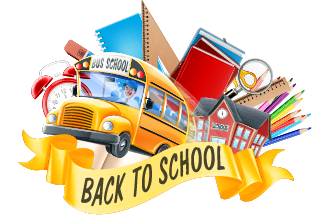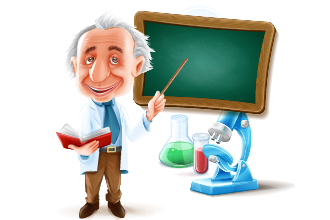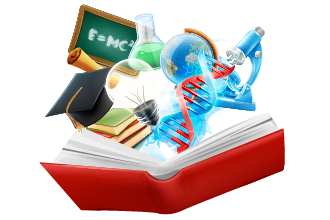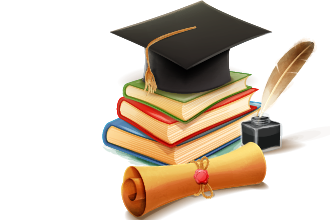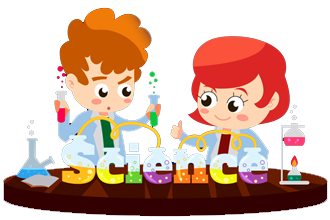Teaching projects
Discussion on the Landscape of Flower (Fruit) Plants in Middle School Campus - Guo Yuzheng, No. 50 Middle School, Hefei City
Discussion on the Landscape of Flower (Fruit) Plants in Middle School Campuses
——Taking the Plant Landscape of the New Campus of Hefei No.50 Middle School as an Example
Guo Yuzheng, Tian'ehu Campus, New School of Hefei No. 50 Middle School
Abstract: Taking the campus plant landscape of Hefei No.50 Middle School New Area as an example, this paper elaborates in detail on the principles and zoning planning of flower (fruit) plant landscape in high school campuses. I hope to provide reference for improving the ecological and aesthetic aspects of plant planting design in the landscape of high school campuses.
Keywords: Middle school campus; Flower (fruit) plants; Plant landscape; Partition planning
1 preface
With the transformation of China's middle school education ideology and educational goals, the campus environment of middle schools has a significant impact on the quality education and physical and mental health of middle school students. Due to the objective reality of China's national conditions, many schools still provide exam oriented secondary education, and students face great learning pressure. Under the dual pressure of teachers and parents, the mechanical lifestyle of attending classes, eating, doing homework, and sleeping in middle school students, which makes it difficult for many middle school students to experience the joy of youth. I often think about how schools can better create a green landscape on campus, in order to better relieve pressure on middle school students, create a lively, relaxed, and enjoyable campus environment, and stimulate students' enthusiasm for life and learning? Through consulting materials, please ask the teacher, I will try to transform the landscape of flower (fruit) plants in the school's environmental greening. I will choose different plant species more scientifically, and cleverly configure and design the landscape. We will decorate our campus with flowers and fruits of trees, shrubs, and herbs, creating a campus landscape with flower (fruit) plants as the theme of "flowers in the four seasons, changing scenery step by step", To stimulate students' love for nature, understand the mysteries of flower knowledge, and appreciate the beauty of life.
2 Principles of plant landscape composition
2.1Principle of adapting to local conditions
There are significant differences in the geographical environment (climate, hydrology, soil, etc.) of different regions, so the principle of suitable planting should be followed in plant configuration. Plants suitable for local planting should be selected to ensure good growth and make the campus vibrant. Hefei belongs to the North Subtropical deciduous, evergreen broad-leaved mixed forest area, with the main climatic characteristics of clear monsoon, distinct four seasons, and moderate rainfall. Suitable plants for planting include acacia, Japanese early cherry, Japanese late cherry, Chinese flowering crabapple, winter jasmine, golden bell, crape myrtle, white magnolia, purple magnolia, two tree magnolia, wood hibiscus, osmanthus, peacock grass, hundred day red, a string of red, pansy, petunia, sunflower, etc.
2.2Diversity principle
In natural conditions, plant communities are often multi species and mixed, with relatively abundant plants. Because communities with a single structure are very fragile and unstable, they are highly susceptible to external environmental influences, which can lead to community degradation. So, when creating landscapes, try to respect the plant diversity inherent in nature, select as many different plants as possible, and make reasonable arrangements.
2.3Functional principle
The school mainly includes functional areas such as the front area, teaching area, living area, and extracurricular activity area. When designing, it should be arranged according to the different characteristics of each functional area. It should not only meet the material functions of teaching, work, learning, and life, but also meet the spiritual functions of enhancing teacher-student communication, improving cultivation, and cultivating sentiment. The front area of the school is an important display area for promoting the school's external image, so the design adopts a simple, generous, and lively approach, while the living area adopts a casual and friendly design approach, creating a pleasant space to meet the participation functions of teachers and students in leisure, sightseeing, viewing, and other experiences.
2.4the principle of economy
From an economic point of view, the general funds for the greening construction of the middle school campus are relatively tight, and there is a lack of professional and technical personnel for maintenance and management. Therefore, plants with high cost performance, rich seasons, long viewing period, strong adaptability, extensive management, and low maintenance costs should be selected as far as possible, such as Mount Huangshan Luan tree, crape myrtle, redbud, pomegranate, green peach, canna, sorrel, sunflower, onion lotus, etc.
2.5 security policy
Campus is a densely populated area, so safety issues cannot be ignored. On campus, it is not advisable to plant flowers, plants, and trees with excessive flying hair, thorns, odors, toxins, or easily causing allergic reactions, such as oleander, camphor tree, phoenix tail orchid, etc. Their flowers, leaves, or juices are toxic; Also known as goji bone, seabuckthorn, rose, etc., their plants are prickly.
3 Overview of Campus Plants in Hefei No.50 Middle School New Area
Hefei No.50 Middle School is a shining pearl of Hefei Education. It is located in Shushan District, southwest of Hefei, formerly known as Luzhou, and consists of four major campuses: East, West, South, and New. Among them, the new area officially started construction in 2009 and officially enrolled students in 2010, covering an area of approximately 75 acres. The overall planning of the school is neat, with clear functional zoning and a large green area (Figure 1). After on-site investigation, the statistics of plant species planted on campus are shown in Table 1.
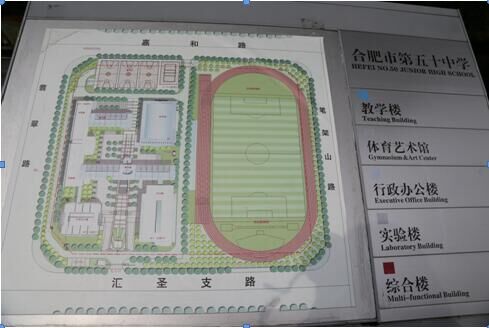
Figure 1 Plan of the New Campus of No. 50 Middle School
表1 五十中新校区绿化现状植物调查结果一览表
|
character |
Plant name |
Number of species |
|
tree |
Cinnamomum camphora, privet, cedar, palm, Mount Huangshan Luan, Magnolia grandiflora, Osmanthus fragrans, peach, red maple, purple leaf plum, Chuisi crabapple, Italian poplar, gingko, bamboo |
14 |
|
shrub |
Cycas, Red leaf Photinia, Lagerstroemia speciosa, Dragon's claw locust, Haitong, Red flower Loropetalum chinense, Golden leaf Ligustrum lucidum, Gardenia, Hibiscus, Flower leaf vine Changchun flower |
10 |
|
herbaceous |
Fine leaved Ophiopogon japonicus, Heavenly Grass, Scallion Lotus |
3 |
It can be seen from Table 1 that there are 27 kinds of campus greening plants, which are relatively abundant, mostly woody flowers, such as privet, Mount Huangshan Luan, Magnolia grandiflora, osmanthus, peach, purple leaf plum, crabapple, crape myrtle, tung, Loropetalum chinense, gardenia, hibiscus, periwinkle, accounting for 50% of the total number of plants. The result of seasonal analysis is that there are 4 kinds of peach trees, purple leaf plums, weeping crabapple, and Loropetalum chinense flowering in spring, 7 kinds of summer flowers, such as privet, magnolia grandiflora, crape myrtle, tung, gardenia, hibiscus, and periwinkle, and 4 kinds of autumn flowers, such as Mount Huangshan Luan, onion lotus, osmanthus, and Loropetalum chinense chinense (except for spring flowers, they can bloom again during the National Day). The result of hue analysis is that there are five kinds of red flowers: peach tree, purple leaf plum, crabapple, crape myrtle, and Loropetalum chinense; five kinds of white flowers: privet, magnolia grandiflora, sea tung, gardenia, onion lotus; two kinds of Mount Huangshan Luan and osmanthus; two kinds of blue purple flowers: hibiscus and periwinkle.
From the current survey, it can be seen that the original design plant species were relatively monotonous, and Italian poplar is now not suitable for planting, with more flying catkins in spring. The ground cover herbaceous plants are relatively monotonous.
4 Questionnaire Survey and Analysis
In order to further understand the application of flowering plants on the campus of the New Area of No. 50 Middle School, I conducted a questionnaire survey on 200 students and 50 teachers, and a total of 229 valid questionnaires were collected. Conduct data analysis on the questionnaire as follows:
A question was set regarding the necessity of planting ornamental plants on campus:
1. Do you want flowers on campus every season?
A. I hope B. I don't want C. It doesn't matter
202 people chose A for this question, 3 people chose B, and 24 people chose C. The detailed proportion is shown in the following figure:
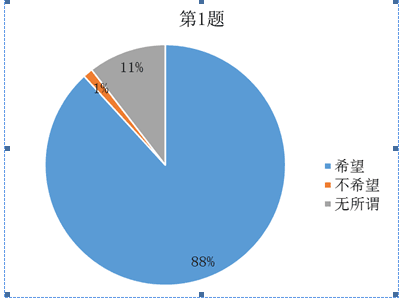
As shown in the above figure, the vast majority of people hope to have flowers on campus every season, which shows that it is necessary to plant flowering plants on campus.
Two questions were set regarding the impact of flowering plants on people:
2. If you can see beautiful flowers or smell the pleasant fragrance of flowers when you enter the campus, can it make you feel relaxed?
A. Yes B. No
3. Do you think planting more flowers on campus will help cultivate your love for plants and nature?
A. Yes, B. No, C. There may be
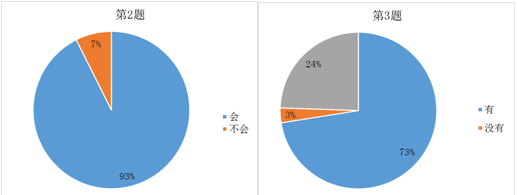
From the data statistics on the above two questions, it can be seen that the vast majority of people believe that flowering plants have a positive impact on themselves.
Four questions were set regarding people's preferences for flowering plants:
4. What color of flowers do you like?
A. Red B. Yellow C. White D. Blue Purple E. Other____________
5. Which aspect of flowers do you prefer more?
A. Fragrance B. Flower color C. Flower shape
6. Which season do you want to spend more?
A. Spring B. Summer C. Autumn D. Winter
7. What type of flowers do you like?
A. Flowers on big trees B. Shrubs on the ground C. Flowers in pots
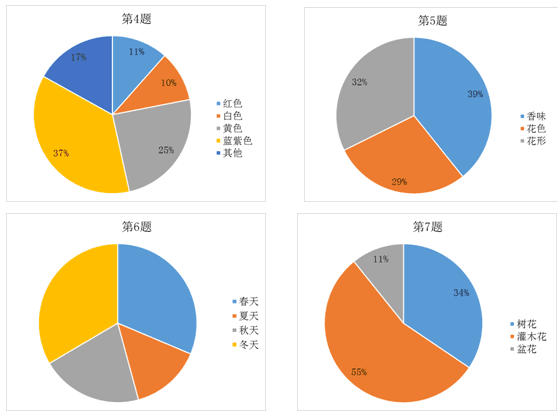
For the choice of flower color, people seem to prefer blue purple and yellow flowers; In terms of the characteristics of flowers, people do not have a particular preference for them; Among the four seasons of spring, summer, autumn, and winter, people prefer to see flowers in winter and spring; As for the types of flowering plants, shrub flowers are popular among most people.
A total of one question is set for campus plant management:
8. What is your opinion on the phenomenon of some flowers and plants growing in disorder on campus?
A. Hope the school has a dedicated person to regularly prune and manage B. Hope the school organizes students to regularly prune
C. Disorder is also a form of beauty D. Other____________________
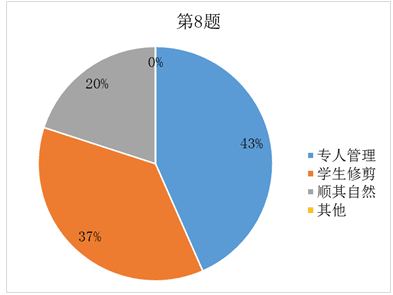
From the above figure, it can be seen that in terms of campus plant management, the vast majority of people believe that someone needs to manage and prune. Most people believe that it should be managed by a dedicated person, while a few believe that regular pruning by students can be organized.
A total of one question is set to address the current situation of the application of campus flowering plants:
9. What are your opinions and suggestions on the current situation of flower planting in schools?
Very satisfied, no need for improvement
There are fewer types of flowers, it is recommended to increase the variety of flowers
□ There are fewer flowers, it is recommended to plant more flowers
Campus flowers are monotonous, it is recommended to plant more flowers of different colors
□ Other__________________________________
From the above figure, it can be seen that the vast majority of people believe that flowering plants need improvement, and it is recommended to increase the number, variety, and color of flowering plants.
Based on field investigations and questionnaire analysis, the current problems in the application of flowering plants on campus include: ① a lack of herbaceous plants, especially perennial herbaceous plants such as canna, scallion lotus, red sorrel, lycoris, iris, and daylily; ② Lack of shrub flowers, such as azalea, winter jasmine, golden bell, etc.; ③ Lack of winter flowers, such as plum and wintersweet; ④ Blue and purple flowers should also be abundant, such as violets, pansies, purple calamus, impatiens, etc Yellow flowers should also be increased, such as golden peach, golden plum, Yunnan Huangxin, etc.; ⑥ Lack of movable potted flowers displayed in corridors of teaching and experimental buildings, such as camellias, camellias, candles, Belgian azaleas, etc.; ⑦ Lack of ornamental fruit plants, such as South Tianzhu, Fuguizi, and persimmon trees; ⑧ Lack of management personnel for campus plants or regular organization of student pruning.
5 Selection and configuration of flower (fruit) plant varieties in various functional areas of the campus
5.1Campus surrounding area
The surrounding area of the Fifty Middle School New Area is surrounded by an iron fence. The plants planted on the inner side of the walls on the east and west sides are mainly holly, with magnolia planted at intervals, and red leaf photinia and golden leaf privet planted at intervals on the outer side; The south and north sides are entrances, with a relatively rich variety of plant species. The plants planted on the inner side include holly, paulownia, and osmanthus, while the plants planted on the outer side include purple leaf plum, camphor, red flower Loropetalum chinense, cedar, osmanthus, and scallion lotus.
Due to the lack of dedicated personnel for management, the trees have grown in a disorderly manner, with most of the golden leaf privet withering (as shown in Figure 2), a few of the red leaf heather also withering, and the scallion lotus, which is planted on both sides of the school gate, has mostly been trampled on, causing the land to be exposed (as shown in Figure 3).

Figure 2 Current Situation of Greening on the East Outside of the Campus
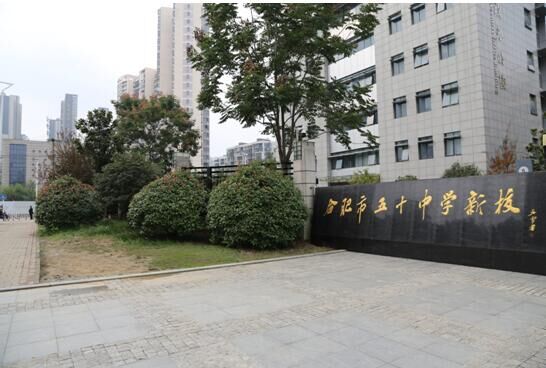
Figure 3 Current Situation of Greening on the Left Side of the South Gate of the CampusHefei No.50 Middle School is located in the urban area of the government, which is relatively bustling with high pedestrian and vehicle traffic. Therefore, the selection of plants around the campus should first pay attention to their dust-proof and noise reduction functions. Therefore, it is recommended to replace the withered golden leaf privet on the outside with red flower Loropetalum chinense, and plant red leaf photinia to fill the gaps in the surrounding area to achieve dust-proof and noise reduction effects; Secondly, attention should be paid to aesthetics. Therefore, it is recommended to plant trample resistant grass seeds on both sides of the school entrance, such as ryegrass, and add seasonal flowering plants, such as purple cauliflower in spring, pansy in summer, scallion lotus in autumn, kale in winter, and a fence with a height of about 15 cm.
5.2 Campus entrance area
Tall camphor trees (Figure 4) are planted on both sides of the road in the southern entrance area of the Fifty Middle School New Area, and wheat winter is planted under the trees. On both sides of the road in the northern entrance area (Figure 5), ginkgo biloba, cedar, red Loropetalum chinense, and red leaf heather are planted, and paradise grass is also planted.
Among them, the growth of Maidong in the southern entrance is poor (Figure 6), while the growth of Paradise Grass in the northern entrance is disorderly, and most of the golden leaf privet withers away (Figure 7), causing some of the land to be exposed, making the northern entrance area appear relatively messy.
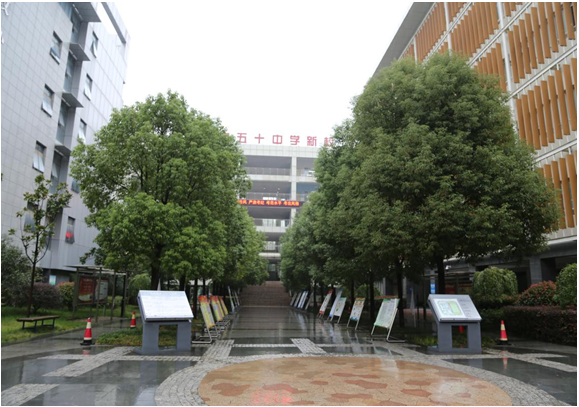
Figure 4 Campus South Entrance

Figure 5 Under the Camphor Tree at the South Entrance of the Campus

Figure 6 Campus North Entrance

Figure 7 Plant death phenomenon at the north entrance of the campus
The entrance and exit of the campus is people's first impression of the school, which should be simple and elegant without losing its beauty. This is not only determined by the architectural design of the entrance, but also related to the surrounding plant configuration. Suggest replanting more Ophiopogon japonicus at the southern entrance; To replant Paradise Grass and Red Leaf Photinia on the east side of the northern entrance, and to replace the dead Golden Leaf Ligustrum with Red Flower Loropetalum on the west side, with regular pruning. This way, the entrance area can present a vibrant scene throughout the year.
5.3Teaching and research area
The teaching and research area of the Fifty New Area includes teaching buildings, experimental buildings, administrative office buildings, and comprehensive buildings. The plants planted around the administrative office building and the comprehensive building include red leaf heather, red flower loropetalum chinense, dragon claw locust, osmanthus, magnolia grandiflora, palm, sea tung, camphor tree, crape myrtle, hibiscus, and bauhinia; Bamboo, cedar, and palm trees are planted around the teaching building; The plants planted around the experimental building include gardenia, weeping crabapple, camphor, and magnolia.
The arrangement of plants around the administrative office building and the comprehensive building is relatively reasonable, but the number of flowering (fruiting) plants is relatively small; The distance between the trees around the teaching building and the experimental building is too close (Figure 8, Figure 9), and the plants are growing well. As the plants grow, the side effects of shading from sunlight will become more and more obvious. Therefore, more consideration should be given to small trees, deciduous trees, etc. around the building. In summer, appropriate shading can be provided, while in winter, falling leaves will not affect the lighting of the classroom.
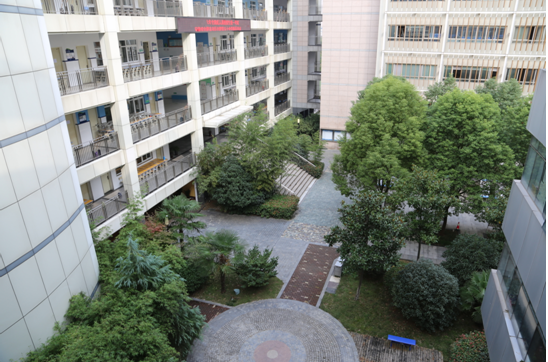
Figure 8 Rest Area between Administrative Office Building and Teaching Building
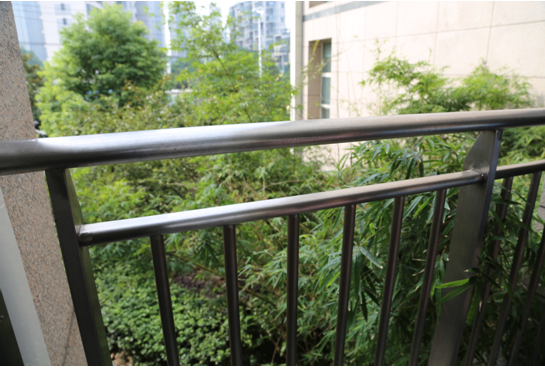
Figure 9: Corridor on the 3rd floor of the experimental building
Teachers and students working and studying in this area, choosing flowers, should focus on creating a peaceful, fresh, and comfortable learning environment. It is recommended to increase the planting quantity of crape myrtle, hibiscus, and bauhinia around the administrative office building and comprehensive building. Transplant the bamboo, camphor, and magnolia trees adjacent to the teaching and experimental buildings to both sides of the school road, and then replant some deciduous trees to facilitate lighting and ventilation in the classroom. It is recommended to choose wintersweet, purple magnolia, and Japanese evening cherry trees, and add potted flowers in each classroom. The flowers that can be selected include camellia, camellia, candlelight, Belgian rhododendron, carnation, four season gardenia, marigold, peacock grass, pansy, colorful leaf grass, longevity flower, crab claw orchid, etc.
5.4 Sports Area
The sports area in the Fifty New Area is mainly composed of three parts - a sports stadium, a basketball court, and a sports field. Planting seaweed and red leaf heather at intervals around the gym, with distinct layers and proper pruning (Figure 10); The basketball court is surrounded by iron railings and planted with camphor, corundum, and poplar trees; There are rich tree species around the playground, including camphor, red leaf heather, Loropetalum chinense var. rubrum, purple leaf plum, Mount Huangshan Luan, osmanthus, privet, magnolia grandiflora and holly.
However, on the south side of the basketball court, only camphor trees were planted in a single area, lacking a combination of shrubs and low trees (Figure 11), resulting in weak noise reduction and dust retention effects; The plant planting on the northwest side of the sports field is relatively sparse, which cannot effectively reduce noise, and there is land exposure caused by stepping on the grassland at the entrance (Figure 12).

Figure 10 South Side of the Gymnasium
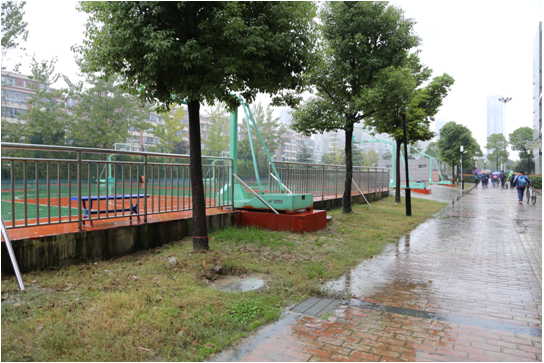
Figure 11 South side of basketball court
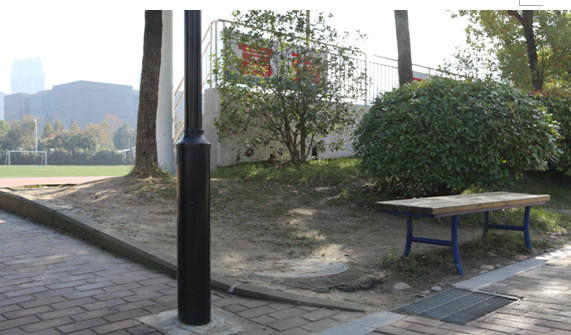
Figure 12 Entrance to the northwest side of the sports field
There is a lot of dust here, so it is important to pay attention to the ability of plants to absorb dust and purify air. It is recommended to add some low shrubs on the south side of the basketball court to increase the dust retention effect. Haitong can be used, and the seasonal changes are obvious, which has a good viewing effect; On the northwest side of the sports field, plant some southern bamboo with beautiful shapes and bright red fruits, showcasing the youth and vitality of the sports field. Additionally, plant trample resistant ryegrass on the exposed land on the west side.
6 Conclusion
Campus is a place for education, where every plant and plant showcases unique natural beauty to people, exuding the unique culture and educational philosophy of the school, which is beneficial to the physical and mental health of the educated. Therefore, I hope to use flowering (fruit) plants to create a good environmental landscape on campus, so that we students can not only acquire knowledge but also feel the beauty of nature, stimulate our interest in life, and enhance our enthusiasm for learning.
Reference:
Zhao Lu. Brief Discussion on Campus Greening Design. Shanxi Architecture, 2007, 33 (32): 351-352
[2] Zhang Jiahong. Insufficient campus landscaping and countermeasures [J]. Landscape and Design, 2007 (30): 276
[3] Hua Zebing. Greening and Beautification of Newly Built Campuses [J]. Journal of Anshan University of Science and Technology, 2004, 27 (2): 152-157
Xu Yuxiu. On Campus Landscape Design. Foreign Building Materials Technology, 2007, 28 (1): 114-115
Xiao Yuncheng. Campus greening and plant landscaping [J]. Anhui Agricultural Science, 2006, 34 (20): 5233-5234
[6] Yuan Xueying. On Modern Campus Greening [J]. Journal of Nantong Institute of Technology (Social Science Edition), 2004, 20 (4): 101-103
[7] Cheng Chaoxia. Exploration and Reflection on Garden style Schools [J]. Heilongjiang Agricultural Science, 2010 (5): 96-99
[8] Chen Xiaoqing, Zhu Jianxin, Xu Xiuhuan. Exploring the Ecological Landscape Planning Model of Campus Environment [J]. Chinese Landscape Architecture, 2002 (3): 41-43
Cai Dawei, Wang Yalin, Zhang Baosen, Liu Hong. The Inheritance and Expression of Campus Culture in University Campus Greening [J]. Heilongjiang Agricultural Science, 2012 (8): 93-94
appendix
|
Serial Number |
Plant name |
Family and Genus |
Morphological characteristics |
Morphological characteristics |
|
1 |
Camphor tree |
Lauraceae
Camphor genus |
Evergreen large tree with a broad oval crown and a camphor scent. |
I love light more, like warm and humid climates, and am more resistant to water and humidity. |
|
2 |
privet |
Oleaceae |
Evergreen shrubs or trees, flowering from May to July, and fruiting from July to May of the following year. |
Likes light and shade, prefers warm and humid climates, has good cold resistance, and is resistant to water and humidity. |
|
3 |
cedar |
Pinaceae |
Evergreen tree with a pointed tower shaped crown, with flat branches and slightly drooping branches. |
Likes light, slightly tolerant of shade, and prefers a mild and cool climate. |
|
4 |
palm |
Palmae Palm genus |
Evergreen trees; The leaves are nearly circular. |
I prefer a warm and humid climate, enjoy light, have strong cold resistance, and slightly tolerate shade. |
|
5 |
Mount Huangshan Luanshu |
Anzaceae Luan Tree Genus |
Deciduous trees; Double pinnate compound leaves; Yellow flowers, flowering from July to September; The capsule is light purple red, with a fruiting period from August to October. |
I prefer a warm and humid climate, resistant to cold, drought, and poverty. |
|
6 |
magnolia grandiflora |
Magnoliaceae
|
Evergreen trees; Oval shaped leaves; The flowers are white and fragrant, with a flowering period from May to June. |
I enjoy a warm and humid climate, enjoy light, and am more resistant to cold. |
|
7 |
Osmanthus tree |
Oleaceae
|
Evergreen small trees; Oval shaped leaves; The flowers are yellow and fragrant, with a flowering period from September to October. |
I enjoy a warm and humid climate, enjoy light, and endure cold. |
|
8 |
peach |
Rosaceae
|
Deciduous small trees; The leaves are narrow elliptical in shape; Pollen colored, sometimes white, with flowering from March to April. |
Likes light, is drought resistant, and cold resistant. |
|
9 |
Red maple |
Aceraceae
|
Deciduous small trees; Leaf palmate deep fissures; The leaves are red in spring and autumn, and purple in summer. |
I prefer a warm and humid climate, which is more tolerant of shade and cold. |
|
10 |
Purple leaf plum |
Rosaceae
|
Deciduous small trees; Leaves elliptical, purple; The flowers are white and bloom in April. |
I enjoy a warm and humid climate, enjoy light, and am more resistant to water and humidity. |
|
11 |
malus halliana |
Rosaceae
|
Deciduous small trees; Leaves ovate; Pollen colored, flowering from March to April. |
I prefer a warm and humid climate, prefer light, and am not very tolerant of shade or cold. |
|
12 |
Yiyang |
Salicaceae
|
Deciduous large trees; Leaf blade triangular, base heart-shaped. |
I enjoy a warm and humid climate and light. |
|
13 |
ginkgo |
Ginkgo family
Ginkgo genus |
Deciduous large trees; Leaf fan-shaped. |
I enjoy a warm and humid climate, enjoy light, endure cold, and drought. |
|
14 |
Phyllostachys |
Gramineae
|
Arbor shaped bamboo species; The leaves are oblong-lanceolate. |
Strong resistance, able to withstand low temperatures, but avoid poor drainage. |
|
15 |
Purple Magnolia |
Magnoliaceae
|
Deciduous shrubs or small trees; Leaves elliptical; The flowers are purple red and bloom from March to May. |
I prefer a warm and humid climate, prefer light, and am more resistant to cold and drought. |
|
16 |
prunus lannesiana |
Rosaceae
|
Deciduous trees; Leaves elliptically ovate; The flowers are pure white, pink white, deep pink to light yellow, and they bloom from April to May. |
Joyful light; Has a certain degree of cold resistance. |
|
17 |
Cycas revoluta |
Cycadaceae
|
Evergreen trees; The leaves are obovate and narrowly lanceolate. |
I prefer a warm and humid climate, prefer light, and am not resistant to cold. |
|
18 |
photinia fraseri |
Rosaceae
|
Evergreen small trees; Leaves long elliptical to oblong-lanceolate; The new leaves are red in spring and turn green in summer. |
I prefer a warm and humid climate, like light, slightly resistant to shade, strong cold resistance, and not resistant to water and humidity. |
|
19 |
crape myrtle |
Qianqucai
|
Deciduous shrubs or small trees; The leaves are elliptical in shape; The flower colors are rose red, bright red, deep pink, light red, purple, and white, with a flowering period from June to September. |
I prefer a warm and humid climate, enjoy light, slightly tolerant of shade, drought, and cold. |
|
20 |
Chinese pagoda tree |
Leguminosae
|
Deciduous trees; Leaves ovate lanceolate; The flowers are white or light yellow, and they bloom from July to August. |
Likes light, slightly resistant to shade, and can adapt to dry and cold climates. |

